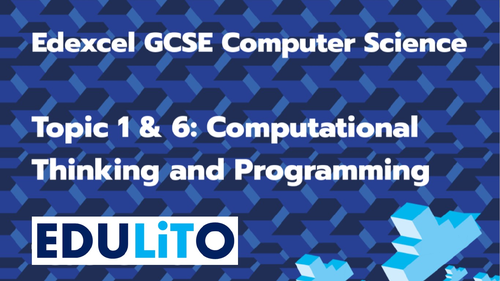








These adaptable Powerpoint Presentations (274 Slides) cover all aspects of the specification in relation to Edexcel GCSE Computer Science 1CP2 (from 2020) topic 1 and topic 6.
These two topics have been combined so that students can learn about algorithms and at the same time have the opportunity to understand how algorithms can then be developed into programs. The programming language used is Python.
It includes:
Teaching PowerPoints (including checkpoint questions and answers)
Student PowerPoints (Including checkpoint questions, but omits the answers)
Content Covered:
Topic 1
· understand the benefit of using decomposition and abstraction to model aspects of the real world and analyse, understand and solve problems
· understand the benefits of using subprograms
· be able to follow and write algorithms (flowcharts, written descriptions, draft program code or assessment reference language) that use sequence, selection, repetition (count-controlled, pre-conditioned, post-conditioned) and iteration (over every item in a data structure), and input, processing and output to solve problems
· understand the need for and be able to follow and write algorithms that use variables and constants and one- and two-dimensional data structures (strings, records, arrays)
· understand the need for and be able to follow and write algorithms that use arithmetic operators (add, subtract, divide, multiply, modulus, integer division), relational operators (equal to, less than, greater than, not equal to, less than or equal to, greater than or equal to) and logical operators (AND, OR, NOT)
· be able to determine the correct output of an algorithm for a given set of data and use a trace table to determine what value a variable will hold at a given point in an algorithm
· be able to identify and correct errors (logic, runtime) in algorithms
· understand how standard algorithms (bubble sort, merge sort, linear search, binary search) work
· be able to use logical reasoning and test data to evaluate an algorithm’s fitness for purpose and efficiency (number of compares, number of passes through a loop, use of memory)
· be able to apply logical operators (AND, OR, NOT) in appropriate truth tables to solve problems
Topic 6
· be able to use decomposition and abstraction to analyse, understand and solve problems
· be able to read, write, analyse and refine programs written in a high-level programming language
· be able to convert algorithms (flowcharts, written descriptions) into programs and convert programs into algorithms
· be able to use techniques (layout, comments, meaningful identifiers, white space) to make programs easier to read, understand and maintain
· be able to identify, locate and correct program errors (logic, syntax, runtime)
etc
Get this resource as part of a bundle and save up to 26%
A bundle is a package of resources grouped together to teach a particular topic, or a series of lessons, in one place.
Something went wrong, please try again later.
This resource hasn't been reviewed yet
To ensure quality for our reviews, only customers who have purchased this resource can review it
Report this resourceto let us know if it violates our terms and conditions.
Our customer service team will review your report and will be in touch.